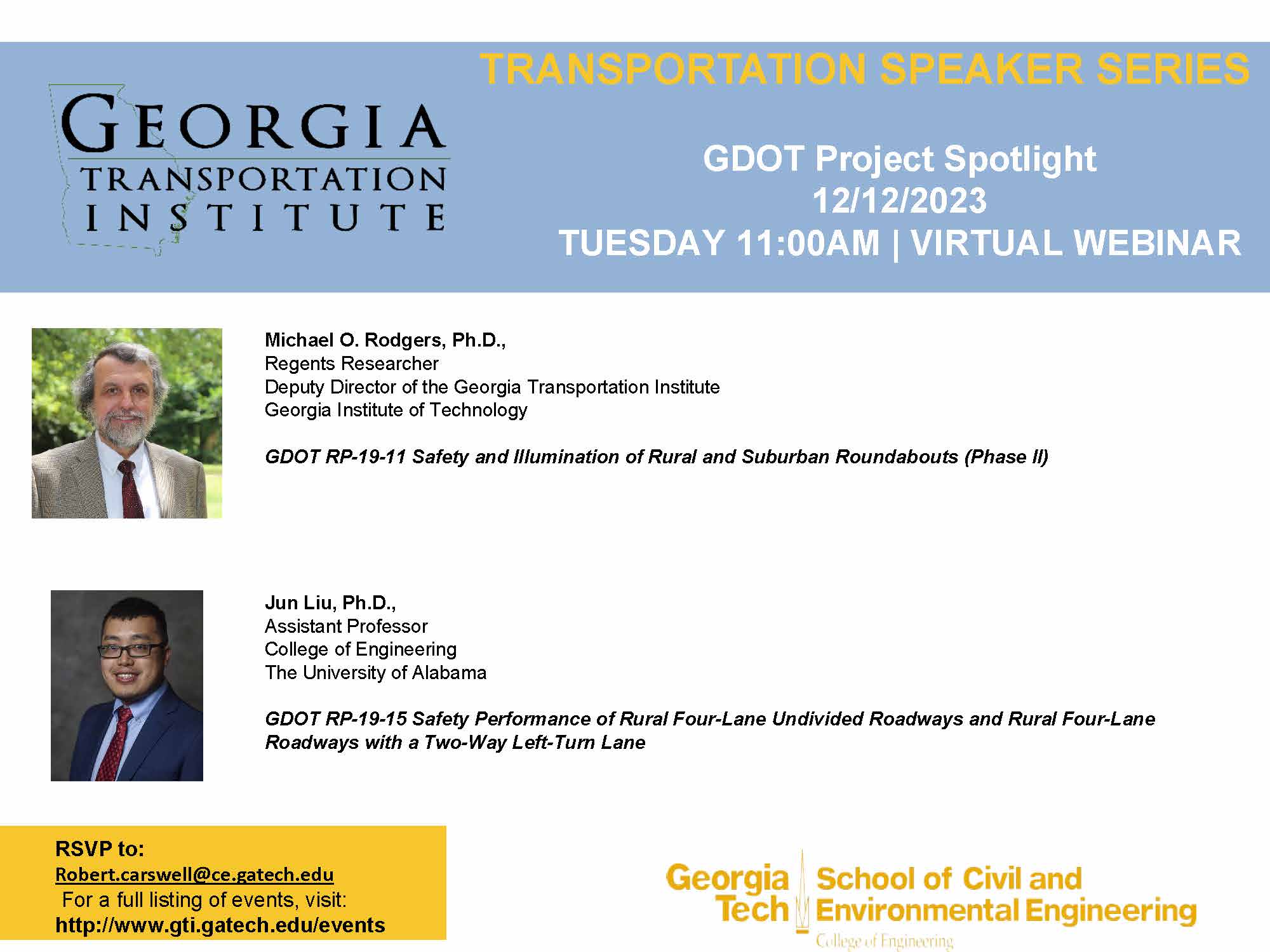GDOT/GTI - Project Spotlight December 2023
Tuesday December 12th, 2023 the Georgia Transportation Institute will hosted a 1-hour webinar that spotlighted two recently completed GDOT Research projects. Each project had maximum of a 15-minute presentation, with a short time afterward for questions.
You can join the event by using the Microsoft Teams link below:

Presenter: Michael O. Rodgers, Ph.D.
Regents Researcher
Deputy Director of the Georgia Transportation Institute
Georgia Institute of Technology
Dr. Rodgers is the director of the Georgia Tech Air Quality Laboratory, holding academic and/or research appointments in the Georgia Tech Schools of Civil and Environmental Engineering, Earth and Atmospheric Sciences, and Public Policy. Dr. Rodgers has a long and distinguished record in air quality research, serving as principal investigator on research projects totaling more than $20 million since 1988 including numerous projects on field and laboratory measurements of pollutants and instrument development and intercomparison. Current activities include managing projects GRASP (Georgia Rural Aerosol Sampling Program) and ON-RAMP (On-Road Ammonia Measurement Program) both of which focus on particulate emissions, conversion and fate. In the area of mobile source emissions, he directs Georgia Tech's efforts in vehicle remote sensing and model validation and is Co-Principal Investigator on the development of the MEASURE model. Dr. Rodgers serves on EPA’s Mobile Source Technical Advisory Subcommittee and Emissions Modeling Workgroup, the U.S. Technical Advisory Group to the International Standards Organization, ASTM International’s Committee D-22 on the Analysis of Atmospheres as well a numerous other technical and policy advisory committees.
Title: GDOT RP-19-11 Safety and Illumination of Rural and Suburban Roundabouts (Phase II)
Abstract:
This project focused on establishing the relationship between the presence/absence or levels of illumination and other geometric and traffic characteristics on nighttime safety at rural and suburban roundabouts. Eighty roundabouts from thirty-seven counties across Georgia were selected to provide a wide range of conditions in terms of illumination layout, illumination levels, number of legs, number of circulating lanes, daily entering volumes, approach speeds, etc. for field measurements of illumination levels. Urban roundabouts with significant pedestrian activity were excluded.
Field data collection at each site included both direct measurements of illumination levels as well as a civil site survey to verify the geometric characteristics of the roundabout and were conducted by measurement teams from Georgia Institute of Technology and Georgia Southern University. The resulting data were processed, joined, and aggregated to the individual site level and used to establish statistical relationships between observed nighttime crash rates, severity, and crash types (e.g., single vs. multiple vehicles, impaired drivers, etc.) and underlying geometric factors and measured illuminance levels. The variation in observed crash rates were modeled against known parameters of the roundabouts to develop a predictive model as to how single vehicle nighttime crash rates were impacted by illumination and other factors.
As expected, multiple vehicle crashes showed no statistically significant dependence on illumination levels as the vehicles themselves, through their head- and taillights, are important contributors to nighttime visibility at the roundabout. This was not the case for single vehicle crashes. Single vehicle crashes were shown to increase for 3-leg roundabouts for illumination values less than 5 lux. No such trend was observed in either 4 or 5-leg roundabouts and these sites showed no statistically significant variation in nighttime single vehicle crash rates at any level of illumination. An overarching conclusion of the study is that there was no observed evidence of illumination values exceeding 5 lux resulting in a statistically significant reduction in nighttime crash rates for rural and suburban roundabouts.
These results suggest that for rural and suburban roundabouts with no significant pedestrian volumes, illumination values significantly lower than current standards may still prove effective as a safety treatment and that, in the absence of a need to protect pedestrians or cyclists at nighttime at a particular location, a reduction in lighting levels or the use of passive retroreflective safety treatments may be a cost-effective treatment.
Presenter: Jun Liu, Ph.D.,
Assistant Professor
College of Engineering
The University of Alabama
Dr. Jun Liu, is an assistant professor of civil, construction and environmental engineering at The University of Alabama. His primary areas of research interests are innovations related to intelligent transportation systems, connected and automated vehicles, transportation planning, highway safety and operation, and sustainable transportation.
Liu has published 25 refereed papers in premier transportation journals and three book chapters in the area of connected and automated vehicles. He also has more than 50 conference presentations/papers and invited talks.
Liu is a member of TRB Standing Committee on Transportation Safety Management and a member of TRB Standing Committee on Geo-spatial Data Acquisition Technologies. He is also a National Cooperative Highway Research Program (NCHRP) Panel Member for NCHRP 20-102(22) State and Local Impacts of Automated Freight Transportation Systems.
He currently serves on the Inaugural Editorial Board of Transportation Research Record: Journal of Transportation Research Board. He is also an Editorial Board member of the Journal of Intelligent Transportation Systems.
He has served as a principal investigator, co-principal investigator or key researcher in projects sponsored by the National Science Foundation, U.S. Department of Transportation, U.S. Department of Energy, Tennessee Department of Transportation, Texas Department of Transportation, Virginia Department of Transportation and Alabama Department of Transportation.
Liu received his doctorate in civil engineering from the University of Tennessee, Knoxville. Prior to joining The University of Alabama in 2018, Liu worked as a transportation planner at Virginia Department of Transportation and as a post-doc researcher at the University of Texas at Austin.
Title: GDOT RP-19-15 Safety Performance of Rural Four-Lane Undivided Roadways and Rural Four-Lane Roadways with a Two-Way Left-Turn Lane
Abstract:
Non-traversable medians consistently yielded improved safety performance compared to other median types such as undivided, 4-feet flush medians, and two-way left-turn lane cross-sections. However, constructing non-traversable medians can be costly. The goal of this study is to 1) examine the safety performance of existing rural four-lane roadways with above-mentioned four median types in Georgia by using Safety Performance Functions (SPFs) and Crash Modification Factors (CMFs), and 2) develop criteria to determine under what conditions these four median types yield maximum safety benefits while considering construction costs. Data were refined and integrated from multiple sources such as from the Georgia Department of Transportation (GDOT), Federal Highway Administration (FHWA) and Google Maps. The Annual Average Daily Traffic (AADT), truck percentage, and access point density were considered as key independent variables in SPFs. The CMFs were estimated to show the effectiveness of a cross-section compared to the base- four-lane undivided roadway. Note, the SPFs and CMFs developed in this study did not consider the speed limit. The key results show that the estimated CMFs vary across different values of variables, indicating that the safety effectiveness of a treatment is likely to vary across different roadway and traffic conditions. Specifically, the segments with non-traversable medians outperformed the other three segment types across all AADTs, truck percentages, and access point densities, except at very low AADT under 5,000 where the 4-feet flush medians appear to have improved safety. The research team estimated average annual crash reductions (compared with undivided roadways), which were converted into monetary values using the average crash costs by severities. The safety benefits and project construction costs were used to estimate benefit-cost ratios (BCRs). Simulations were suggested in situations where safety solely did not help in the decision-making process of identifying cost-effective median type for rural four-lane roadways. It is highly recommended that decision-makers or practitioners use the estimated safety benefits from this study and the construction costs of a specific highway project to estimate BCRs for recommendations of the cross-section type.
Theme by Danetsoft and Danang Probo Sayekti inspired by Maksimer


































